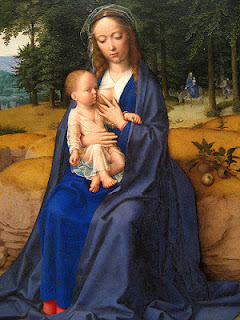In
2004, two famous museums, the Accademia in Venice and the Kunsthistorisches in
Vienna, worked together to mount a ground-breaking Giorgione exhibition. The
Kunsthistorisches agreed to send it’s Giorgione collection that included the
“Three Philosophers”, the “Laura”, and the “Boy with an Arrow” to the
Accademia. In return the Accademia allowed the Tempest to leave Italy for the
first time for the subsequent Viennese showing.
The
exhibition produced a beautiful and valuable catalog with essays and catalog
entries by most of the world’s leading Giorgione scholars. In addition, the
catalog included two appendices on the scientific or technological examination
of some of Giorgione’s works that contained some valuable information that so
far has been little noticed.*
The
first study, “Giorgione’s Materials and Painting Technique: Scientific
Investigation of Three Paintings,” was a joint effort by Elisa Campani,
Antonella Casoli, Enrico Fiorin, and Stefano Volpin. The authors examined the
newly restored “Castelfranco Altarpiece”, the “Tempest”, and the portrait of an
old woman usually called “La Vecchia”. Acknowledging Giorgione’s fame as an
innovator, the authors declared that:
The goal of this diagnostic campaign was to
determine the extent to which Giorgione’s inventiveness manifested itself in a
desire to experiment with new materials and techniques.
Those
interested in the very full discussion of the variety of scientific techniques
used will have to read the article. In brief, I would just like to highlight some of their results and conclusions. The authors believed that their investigation enabled a “complete
reconstruction of Giorgione’s palette in the three masterpieces.” Moreover,
The choice of materials seems to depend on the
result which the artist wished to achieve in each work, adapted to his
expressive requirements and the evolution of his style. (256)
This
conclusion only seems to confirm what everyone has thought of Giorgione and
other Venetian painters but it is good to have it confirmed scientifically. Not
only does his palette vary significantly but so too does his choice of binding
medium. One of the results of the technical examination highlighted,
a significant difference in the painting technique
of the three examined works; the choice of egg tempera to apply colour in the
Castelfranco altarpiece and of a mixed technique, using walnut oil mixed with
egg for La Tempesta and La Vecchia. (260)
The
authors draw the following conclusion that so far does not appear to have
penetrated the Giorgione world.
Even given the limited number of works investigated,
the artist emerges as a figure with a great knowledge of materials and
techniques rather than as an innovator and experimenter. One could say that the
artistic revolution caused by Giorgione does not necessarily translate into
strictly technological innovation. In fact, from this point of view, the
analyses have not highlighted any novel resolutions in the three works. Instead
there is clear evidence of an ability to utilize the extensive materials
available in Venice and of a sound knowledge of the painting techniques
accumulated by Venetian workshops during the 15th century.
Sandra
Rossi and Paolo Spezziani collaborated on the second technical essay,
“Examination via X-Ray and Infrared Reflectography, and Restoration of the
Castelfranco Altarpiece.” Although mainly a discussion of the altarpiece, the
authors did report on a 2001
infrared reflectography examination of both the “Tempest” and “La Vecchia” in
preparation for the 2004 exhibition. This examinination confirmed a pentimento
in the "Tempest" that the catalog still regarded as inexplicable:
investigation enabled a more precise characterization of the
figure on the bridge, who wears a long garment and is seen proceeding to the
right. The figure holds a staff in his left hand; on his right shoulder is a
second stick, from which hangs a container.
Although
this figure cannot be seen even in the infrared image provided in the text, Dr.
Rossi confirmed the existence of the man on the bridge to me as we both stood
in front of the painting in the Accademia in 2010. A man with a staff and a
pilgrim’s sack flung over his shoulder fits no other interpretation of the
painting than “The Rest on the Flight into Egypt.” As so many other painters
did, both before and after, Giorgione originally must have intended to portray
the actual flight in the background with the “Rest” in the foreground. Why he
changed his mind, we will never know. ###
 |
| Gerard David: "Rest on the Flight into Egypt" with flight in background. Metropolitan Museum, NY |
*Ferino-Pagden, Sylvia, and Nepi-Scire, Giovanna: exh. Cat. Giorgione,
Myth and Enigma, Vienna, 2004.


.jpg)
No comments:
Post a Comment